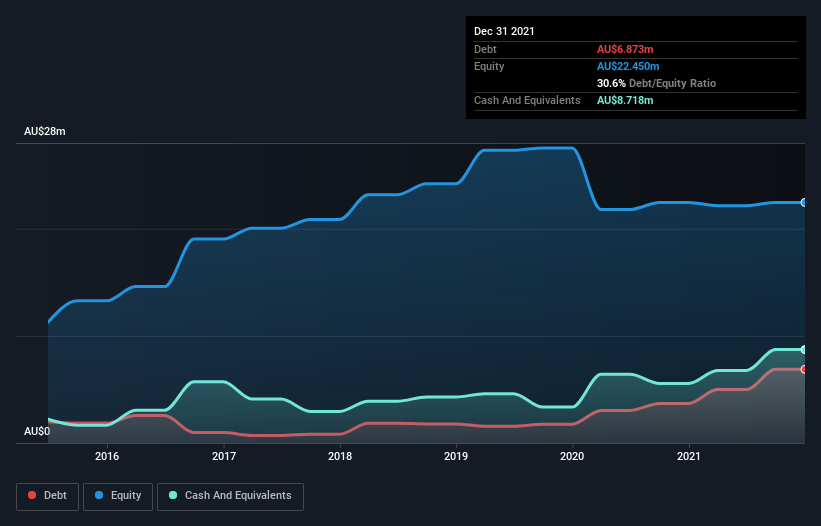Some say volatility, rather than debt, is the best way to think about risk as an investor, but Warren Buffett famously said that 'Volatility is far from synonymous with risk.' When we think about how risky a company is, we always like to look at its use of debt, since debt overload can lead to ruin. We note that Compumedics Limited (ASX:CMP) does have debt on its balance sheet. But should shareholders be worried about its use of debt?
When Is Debt A Problem?
Generally speaking, debt only becomes a real problem when a company can't easily pay it off, either by raising capital or with its own cash flow. If things get really bad, the lenders can take control of the business. However, a more common (but still painful) scenario is that it has to raise new equity capital at a low price, thus permanently diluting shareholders. By replacing dilution, though, debt can be an extremely good tool for businesses that need capital to invest in growth at high rates of return. The first thing to do when considering how much debt a business uses is to look at its cash and debt together.
Check out our latest analysis for Compumedics
What Is Compumedics's Debt?
As you can see below, at the end of December 2021, Compumedics had AU$6.87m of debt, up from AU$3.69m a year ago. Click the image for more detail. However, it does have AU$8.72m in cash offsetting this, leading to net cash of AU$1.85m.

How Healthy Is Compumedics' Balance Sheet?
The latest balance sheet data shows that Compumedics had liabilities of AU$16.5m due within a year, and liabilities of AU$683.0k falling due after that. Offsetting this, it had AU$8.72m in cash and AU$10.9m in receivables that were due within 12 months. So it actually has AU$2.37m more liquid assets than total liabilities.
This short term liquidity is a sign that Compumedics could probably pay off its debt with ease, as its balance sheet is far from stretched. Succinctly put, Compumedics boasts net cash, so it's fair to say it does not have a heavy debt load! The balance sheet is clearly the area to focus on when you are analysing debt. But you can't view debt in total isolation; since Compumedics will need earnings to service that debt. So when considering debt, it's definitely worth looking at the earnings trend. Click here for an interactive snapshot.
In the last year Compumedics's revenue was pretty flat, and it made a negative EBIT. While that hardly impresses, its not too bad either.
So How Risky Is Compumedics?
We have no doubt that loss making companies are, in general, riskier than profitable ones. And the fact is that over the last twelve months Compumedics lost money at the earnings before interest and tax (EBIT) line. Indeed, in that time it burnt through AU$16k of cash and made a loss of AU$31k. Given it only has net cash of AU$1.85m, the company may need to raise more capital if it doesn't reach break-even soon. Overall, its balance sheet doesn't seem overly risky, at the moment, but we're always cautious until we see the positive free cash flow. The balance sheet is clearly the area to focus on when you are analysing debt. However, not all investment risk resides within the balance sheet - far from it. Be aware that Compumedics is showing 3 warning signs in our investment analysis , and 1 of those is potentially serious...
At the end of the day, it's often better to focus on companies that are free from net debt. You can access our special list of such companies (all with a track record of profit growth). It's free.
New: AI Stock Screener & Alerts
Our new AI Stock Screener scans the market every day to uncover opportunities.
• Dividend Powerhouses (3%+ Yield)
• Undervalued Small Caps with Insider Buying
• High growth Tech and AI Companies
Or build your own from over 50 metrics.
Have feedback on this article? Concerned about the content? Get in touch with us directly. Alternatively, email editorial-team (at) simplywallst.com.
This article by Simply Wall St is general in nature. We provide commentary based on historical data and analyst forecasts only using an unbiased methodology and our articles are not intended to be financial advice. It does not constitute a recommendation to buy or sell any stock, and does not take account of your objectives, or your financial situation. We aim to bring you long-term focused analysis driven by fundamental data. Note that our analysis may not factor in the latest price-sensitive company announcements or qualitative material. Simply Wall St has no position in any stocks mentioned.
About ASX:CMP
Compumedics
Engages in the research, development, manufacture, and distribution of medical equipment and related technologies in the Americas, Australia, the Asia Pacific, Europe, and the Middle East.
Undervalued with high growth potential.
Market Insights
Community Narratives


Recently Updated Narratives


MINISO's fair value is projected at 26.69 with an anticipated PE ratio shift of 20x


The Quiet Giant That Became AI’s Power Grid


Nova Ljubljanska Banka d.d will expect a 11.2% revenue boost driving future growth
Popular Narratives


The company that turned a verb into a global necessity and basically runs the modern internet, digital ads, smartphones, maps, and AI.


MicroVision will explode future revenue by 380.37% with a vision towards success



